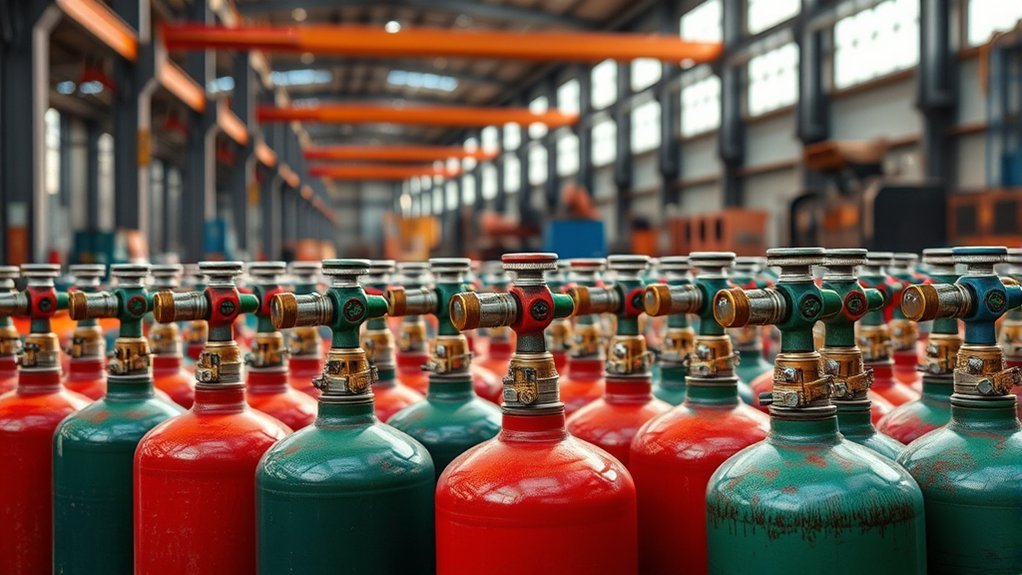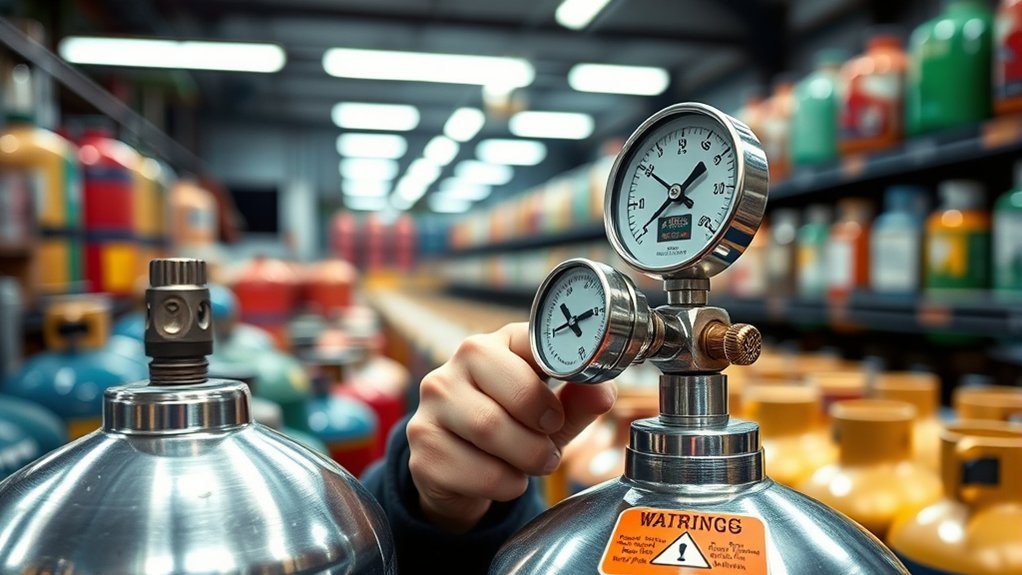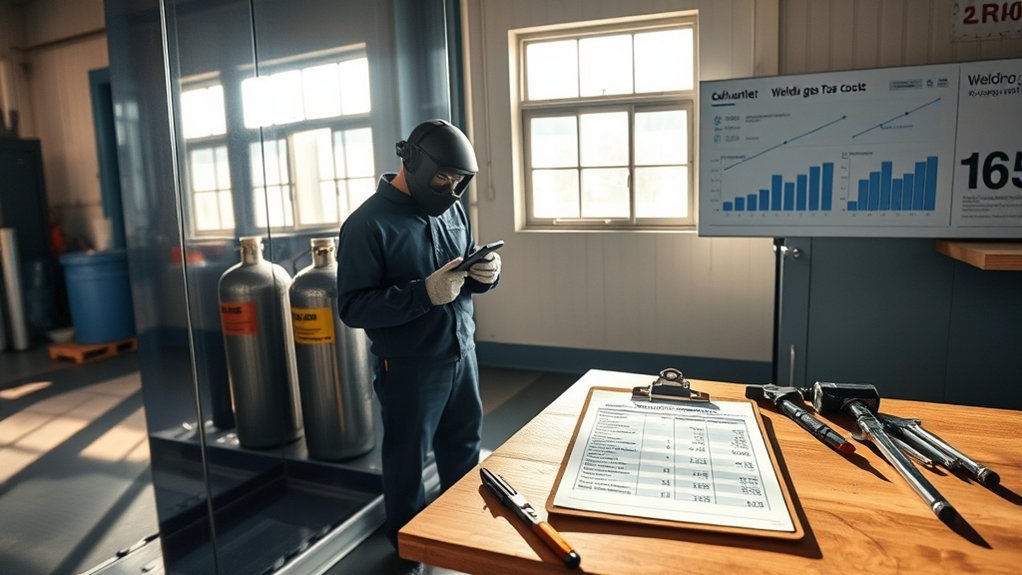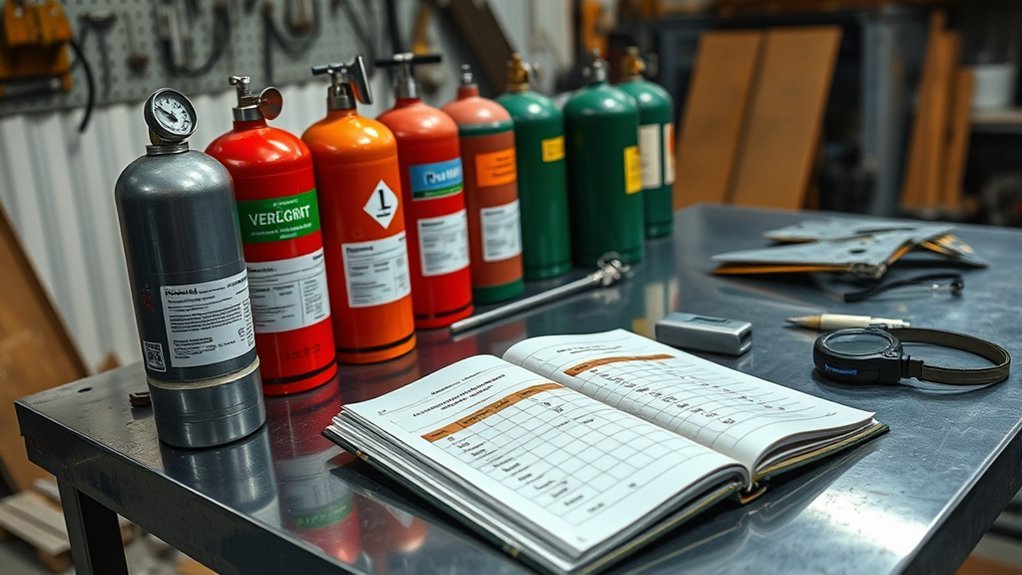Welding gas costs vary depending on tank size and type. For a 40 CF tank, you’ll face initial prices between $230 and $260. Larger tanks, like 125 CF, can range from $350 to $400. Keep in mind that refill expenses also add up, with 40 CF refills around $60 and larger tanks about $70. When budgeting, consider both initial purchase and long-term refill costs. There’s more to discover about optimizing your welding gas expenses!
Common Welding Gasses

Welding gases play an essential role in achieving high-quality welds, each offering unique properties tailored for specific applications.
Among the common welding gas types, argon (Ar) is primarily used for TIG welding, especially effective on aluminum, while helium (He) can enhance penetration when mixed with argon.
Argon is essential for TIG welding, particularly with aluminum, while adding helium can improve penetration.
For MIG welding, carbon dioxide (CO2) is a reactive gas often blended with argon, ideal for mild steel applications. The most popular blend for MIG is 75% argon and 25% CO2, providing a balance of weld quality and penetration.
In oxy-fuel processes, oxygen (O2) boosts flame heat when combined with acetylene (C2H2), making it a preferred choice for high-temperature welding.
Understanding these gas application benefits is vital for peak welding performance.
Tank Cost

When considering tank costs, you’ll notice that a 40 CF welding gas tank typically ranges from $230 to $260, while an 80 CF tank costs between $290 and $320.
Although the initial investment for larger tanks like the 125 CF is higher, they can offer more economical refills over time.
Additionally, many suppliers prefer leasing tanks, which can affect your long-term ownership costs.
Initial Tank Purchase Prices
Purchasing a welding gas tank involves varying costs based on the tank size you choose.
For instance, a 40 CF tank typically ranges from $230 to $260 when full, while an 80 CF tank generally costs between $290 and $320.
If you opt for a larger 125 CF tank, expect to pay between $350 and $400, depending on the supplier.
Larger tanks, such as the 200 CF and 300 CF, may have higher initial costs but can provide more cost-effective refills long-term.
Most gas suppliers prefer to lease and refill tanks instead of selling them outright, which impacts your purchase options and can influence your overall budgeting for welding projects.
Long-Term Ownership Costs
Although the initial purchase price of a welding gas tank is a significant factor, the long-term ownership costs can greatly impact your budget. Conducting a cost analysis reveals the ownership benefits of larger tanks. Here’s a breakdown of typical costs:
| Tank Size | Initial Cost | Annual Refill Cost |
|---|---|---|
| 80 CF | $290 – $320 | $660 (1st year) |
| $360 (subsequent) | ||
| 125 CF | $350 – $400 | $360 (annual) |
Investing in a 125 CF tank means fewer refills and lower overall expenses. While the upfront costs may be higher, the long-term savings can be significant, making it a smart choice for frequent welders.
Refill Expense

When considering refill expenses, it’s essential to understand the costs associated with different tank sizes.
A 40 CF tank typically runs around $60 for a refill, while larger tanks like the 125 CF and 300 CF can be more economical due to similar labor costs.
Additionally, factors such as location, supplier pricing, and HAZMAT fees can greatly impact your overall refill expenses.
Refill Cost by Tank
Welding gas refill costs depend greatly on tank size, with prices typically ranging from $60 for a 40 CF tank to about $70 for both 80 CF and 125 CF tanks. Smaller tanks like the 40 CF require more frequent refills, leading to higher overall costs. In contrast, larger tanks are more cost-effective due to similar labor costs.
| Tank Size (CF) | Refill Cost ($) | Notes |
|---|---|---|
| 40 | 60 | Higher refill frequency |
| 80 | 70 | Moderate refill frequency |
| 125 | 70 | Moderate refill frequency |
| 300 | 125 | Varies by supplier |
| Additional Fees | Varies | HAZMAT fees possible |
Consider these factors to manage your refill expenses effectively.
Frequency of Refills
The frequency of refills plays a significant role in determining your overall welding gas expenses. Your refill frequency is directly influenced by your usage patterns, including the type of welding you perform and your flow rate.
For instance, a standard 80 CF tank, at a flow rate of 10 CFH, can provide approximately 8 hours of welding. If you opt for a 125 CF tank, refilling every three months results in an annual cost of about $280, making it a cost-effective choice for many MIG welders.
Smaller tanks, like the 40 CF tank, require more frequent refills, leading to higher cumulative expenses over time. Consequently, selecting larger tanks can save you money in the long run by reducing refill frequency.
How to Calculate the Real Cost

Calculating the real cost of welding gas involves more than just the initial tank purchase; it requires factoring in refill expenses and usage frequency based on your specific setup.
Start by summing the initial tank price with your expected annual refill costs. For example, an 80 CF tank for TIG welding at $300 with bi-monthly $60 refills totals approximately $660 in the first year, then $360 annually.
In contrast, a 125 CF MIG tank costs around $640 initially with $280 yearly afterward.
Utilizing smaller tanks, such as a 40 CF setup, can lead to higher first-year costs due to less frequent refills.
Always perform a cost comparison among local suppliers to find the best refill strategies that suit your welding needs.
How Long Will Welding Gas Last?

How can you determine how long your welding gas will last? You can calculate the usage duration by dividing the tank volume (in cubic feet) by the flow rate (in cubic feet per hour).
To estimate your welding gas duration, divide the tank volume by the flow rate.
For example, with an 80 CF tank and a flow rate of 10 CFH, you’ll get approximately 8 hours of continuous welding.
- Larger tanks provide longer usage times.
- A pressure gauge helps monitor remaining gas.
- A full tank reads around 2015 psi.
- Gas mixtures can separate if stored too long.
Where to Buy or Refill Your Gas
Finding a reliable source for welding gas is essential for maintaining your projects’ efficiency. You can purchase gas tanks online or from local dealers, but many providers lease and refill tanks instead of selling them outright.
Popular suppliers like Northern Tool and AirGas provide a variety of welding gases, including Argon and CO2 blends, though prices vary greatly between locations. Be mindful that some suppliers only refill tanks purchased from them, limiting your options.
To find the best deals, engage in supplier comparisons and gather community feedback on pricing. Typical refill costs are around $60 for a 40 CF tank and $70 for an 80 CF tank, with larger tanks often being more economical.
Alternatives to Shielding Gas
Welding without shielding gas doesn’t have to compromise quality or efficiency. You can explore several alternatives that keep costs down while maintaining strong welds:
- Self-shielded flux-cored wire: This option eliminates the need for gas tanks, making MIG welding more convenient.
- Stick welding: A cost-effective method that doesn’t require shielding gas, ideal for various applications.
- Gasless MIG welding: Utilizing flux-cored wire can markedly reduce consumable costs compared to traditional gas-shielded methods.
- Mild steel applications: Flux-cored wire can deliver results comparable to gas-shielded MIG welding without the ongoing expense of gas refills.
Understanding these options enables you to adapt to rising gas prices and find economical welding solutions that don’t compromise on quality.
Frequently Asked Questions
What Factors Influence Welding Gas Prices in Different Regions?
Regional pricing and market demand greatly influence welding gas prices. You’ll find costs vary due to local supply chains, economic conditions, and competition among suppliers, impacting accessibility and affordability in different areas.
How Can I Find the Best Local Gas Supplier?
Finding the best local gas supplier is like steering through a maze. Check supplier reviews online, ensuring they have good ratings, and confirm gas availability to meet your needs. This will lead you to the right choice.
Are There Any Discounts for Bulk Purchases of Welding Gas?
Yes, many welding gas suppliers offer bulk purchase discounts. By ordering larger quantities, you often reduce the price per unit. It’s wise to compare suppliers to maximize your savings on welding gas.
What Safety Precautions Should I Take When Handling Welding Gas?
When handling welding gas, guarantee you wear protective gear, maintain proper ventilation, and store cylinders upright. Regularly check for leaks, and keep flammable materials away to guarantee welding gas safety and effective gas handling precautions.
Do Welding Gas Prices Fluctuate Seasonally or Annually?
Welding gas prices do fluctuate, influenced by market trends and seasonal pricing. As you monitor welding gas trends, you’ll notice variations linked to demand spikes during certain times, impacting your overall costs throughout the year.
Conclusion
In the world of welding, the cost of gas can feel like a drop in the bucket compared to the overall project budget, yet it plays a vital role in achieving quality welds. While the initial tank purchase may seem steep, the ongoing refill expenses can be manageable with proper calculations. As you weigh your options, remember that alternatives exist, but they may compromise the precision you seek. Choosing the right gas is essential for both your wallet and your welds.


